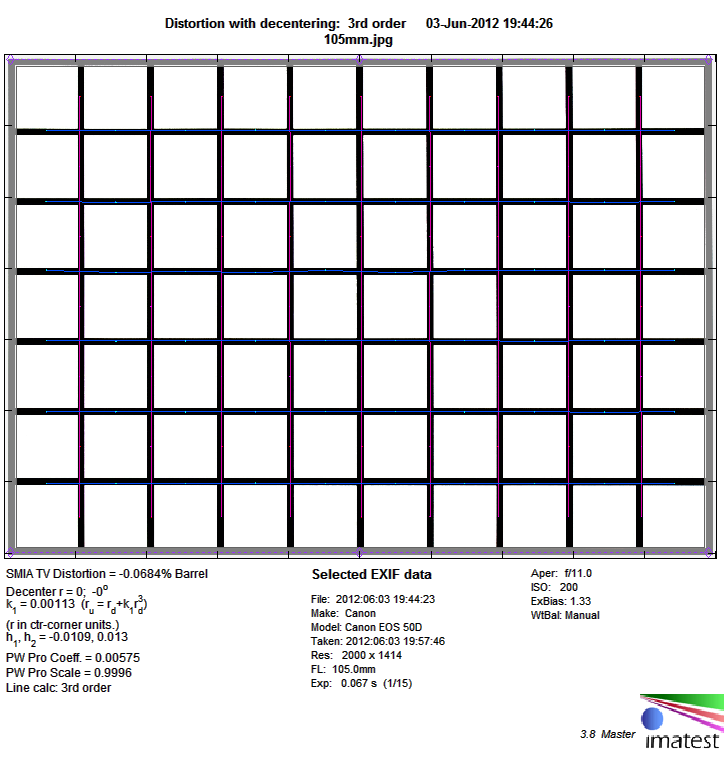|
Sigma AF 105mm f/2.8 EX HSM DG OS macro (Canon EOS) - APS-C Format Review - Analysis |
|
Lens Reviews -
Canon EOS (APS-C)
|
|
Page 2 of 2

Distortion
Typical for most macro lenses the level of distortion is negligible and nothing to worry about.

The chart above has a real-world size of about 120x80cm.
Vignetting
Full format lenses have a natural sweet spot advantage when used on APS-C cameras. Compared to the native full format scope the vignetting is therefore substantially reduced. At f/2.8 you can still spot some light falloff in critical scenes but it's nothing extreme. The vignetting is basically gone from f/4 onward.

MTF (resolution)
We were already impressed by the full format results but they are even better in the APS-C scope. The center quality is already great at f/2.8 and outer image region is also very sharp. This characteristic remains intact till about f/11. At f/16 diffraction effects reduce the quality somewhat but the results are still usable. f/22 should be avoided though.
Please note that the MTF results are not directly comparable across the different systems!
Below is a simplified summary of the formal findings. The chart shows line widths per picture height (LW/PH) which can be taken as a measure for sharpness.
If you want to know more about the MTF50 figures you may check out the corresponding Imatest Explanations

Chromatic Aberrations (CAs)
Lateral CAs are very well controlled with an average width of around 0.3px at the image borders. This is nothing to worry about at all. The CAs are slightly higher than in the full format scope due to the higher pixel density of the APS-C test camera.

Bokeh
The bokeh (the quality of the out-of-focus blur) is a primary aspect for a macro lens and the Sigma lens does not disappoint us here.
Out-of-focus highlights have a smooth inner zone with only a marginal outlining effect at the highlight borders. The "cat's eyes" issue still shows up at the edge of the image frame but it is not as pronounced as in the full format scope and mostly gone by f/4.
 The general blur in the focus transition zone is very smooth and buttery - this is especially true for the background blur.
The general blur in the focus transition zone is very smooth and buttery - this is especially true for the background blur.

Bokeh Fringing / Longitudinal Chromatic Aberrations (LoCA)
Bokeh fringing is a common problem present in most large aperture lenses - it is typically visible as green and purple halos in the out-of-focus zones. However, the Sigma does a better job than usual here although you can still spot a bit of fringing at f/2.8.
|
Move the mouse cursor over the f-stop marks below to observe the respective LoCAs
|
| f/2.8 |
f/4 |
f/5.6 |
|

|
VerdictThe Sigma AF 105mm f/2.8 EX DG HSM OS macro is an impressive lens - both on in its native full format scope and even more so on APS-C format cameras. The APS-C resolution characteristic is great even at f/2.8 and the high quality is basically kept till about f/11. Typical for macro lenses distortions are a non-issue. You may spot a little vignetting at f/2.8 but beyond it's not issue anymore. The quality of the bokeh (out-of-focus blur) is pretty much excellent and the bokeh fringing is comparatively well controlled. Lateral CAs are a very low and nothing to worry about.
The build quality of the Sigma lens is on a very high level. Similar to its Canon counterparts it keeps a constant physical length during focusing. This design is possible by incorporating an inner focusing system which is, in combination with an ultrasonic (HSM) motor, also responsible for the very high AF speed of the lens. Sigma's image stabilizer (OS = optical stabilizer) is, of course, a very welcome addition. It is pretty efficient at standard focus distances although you shouldn't expect wonders from it in macro scenes due to the much more pronounced angular shake here.
The final conclusion remains, of course, "highly recommended"!
|